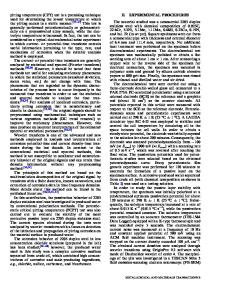Microbial fuel cell for oilfield produced water treatment and reuse: Modelling and process optimization
- PDF / 388,423 Bytes
- 9 Pages / 595 x 842 pts (A4) Page_size
- 21 Downloads / 314 Views
pISSN: 0256-1115 eISSN: 1975-7220
INVITED REVIEW PAPER
INVITED REVIEW PAPER
Microbial fuel cell for oilfield produced water treatment and reuse: Modelling and process optimization Majid Mohammadi*, Mehdi Sedighi**,†, Rajamohan Natarajan***, Sedky Hassan Aly Hassan****, and Mostafa Ghasemi***,† *Department of Energy Engineering, Qom University of Technology, Qom, Iran **Division of Energy Systems, Department of Chemical Engineering, University of Qom, Qom, Iran ***Chemical Engineering Section, Sohar University, Sohar, 311, Oman ****Botany & Microbiology Department, Faculty of Science, New Valley University, 72511 El-Kharga, Egypt (Received 8 April 2020 • Revised 16 August 2020 • Accepted 6 September 2020) AbstractOilfield produced water is one of the vast amounts of wastewater that pollute the environment and cause serious problems. In this study, the produced water was treated in a microbial fuel cell (MFC), and response surface methodology and central composite design (RSM/CCD) were used as powerful tools to optimize the process. The results of two separate parameters of sulfonated poly ether ether ketone (SPEEK) as well as nanocomposite composition (CNT/Pt) on the chemical oxygen demand (COD) removal and power generation were discussed. The nanocomposite was analyzed using XRD, SEM, and TEM. Moreover, the degree of sulfonation (DS) was measured by NMR. A quadratic model was utilized to forecast the removal of COD and power generation under distinct circumstances. To obtain the maximum COD removal along with maximum power generation, favorable conditions were achieved by statistical and mathematical techniques. The findings proved that MFC could remove 92% of COD and generate 545 mW/m2 of power density at optimum conditions of DS=80; and CNT/Pt of 14 wt% CNT- 86 wt% Pt. Keywords: MFC, COD Removal, Power Generation, CNT/Pt Nanocomposite, Optimization
the well declines and the requirement for injection of water and furthermore the amount of produced water will be increased [14]. It is very interesting that the amount of produced water which comes out from a reservoir is around 98% in an old well with just 2% fossil fuel. It is anticipated that, by the aging of the oil and gas wells, the quantity of produced water would be increased in oil as well as gas wells and so it causes a high amount of wastewater and the environmental problems associated with that [15,16]. As the term “produced water” is utilized for the water associated with the produced oil and gas in the reservoir, it has different types. Produced water from different processes has different characteristics. For instance, produced water which is produced from the gas field is more toxic than the oilfield produced water. That is due to the high amount and concentration of aromatic contents such as toluene, xylene, and benzene [13,17]. Due to the large amount of produced water and high toxicity, it cannot be disposed simply into the environment. Furthermore, one of the main considerations in the oil industry is how to treat or reuse the produced water t
Data Loading...











